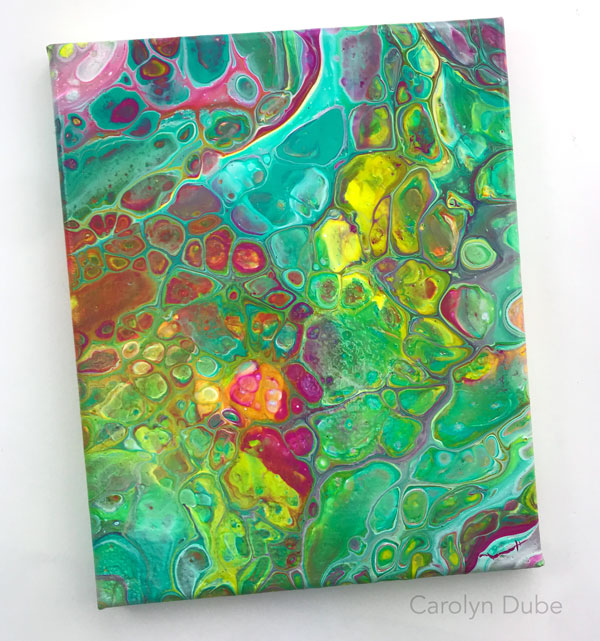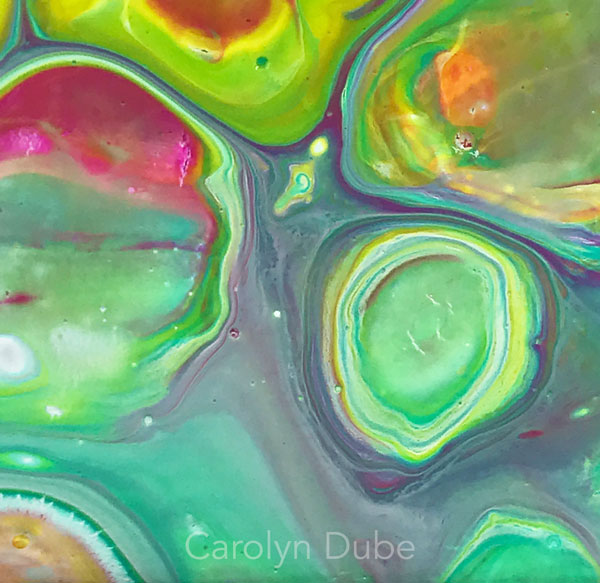
What happens if you use a lot of dimethicone? Will we get more cells? Will it impact the dried canvas?
Insert Video-
Video Password: Every video in the workshop requires a password, it is the same password for every video and it is listed directly under the video so you don’t have to remember a thing. You can copy and paste it, and be sure that there are no blank spaces. The computer elves are very particular about that.
Video Password:PPFUN
Watch/Download on Vimeo. Need help downloading or with other technology issues? Check out the technology help page here.
Now it’s your turn to play. Try using a little and a lot of dimethicone or silicone in your pour.
Questions? Leave a comment here on the lessons page or in our Facebook group. Not a member of the group yet? Go here to see how to join.
Supplies Used (and as always substitute with what you have on hand or prefer to use)
Pouring medium: Deco Art Pouring Medium
Dimethicone
So should you use a little or a lot of dimethicone? That is personal preference. There isn’t a right or wrong to this. It’s about what you love. Want your dried canvas glass smooth? Then you might want to use small amounts of dimethicone. Want tree ring types of cells? Then you might want to use more dimethicone. And there is even a middle ground for you to explore, in between a little and a lot. Now that you understand what happens with it, you can decide what look you want. After all, this course is all about understanding the FUNdamentals of why the paint does what it does.
The canvas on the left has just 1 drop of dimethicone per cup and the canvas on the right has 7 drops per cup. Be aware that not every dropper is the same. My drops tend to be delicate little things because of the cheap plastic pipette, but if I was using a bigger or glass one, the drops may be larger.

I started with a syrup pouring medium so that it would do the flip cup with a gravity assist for the 2nd technique. I wanted the pouring medium to stretch like salt water taffy and the syrup ones are much better for that than a thicker one. I used the DecoArt but the Liquitex would do it well too.
This technique lets gravity pull it, like taffy, so that there are all these layers from the flip cup, not mixed, but stacked on each other, that will let the cells break through since we’ve decreased the surface tension with so much dimethicone.
When you put oils in the paint, the oils tend to rise to the surface as it dries. Once your canvas is totally dry, spray a little rubbing alcohol (I put it into an empty spray bottle) on it and wipe it off with a clean cloth. That will get up any oils.
But there will be craters left behind in the dried paint from where the oil was. This means you won’t have a perfectly smooth canvas.

What is a tree ring cell? This is a super close photo of one of the cells from the 3rd canvas in the video. The one where gravity pulled and stretched the paint like taffy. The way there are different colors of rings reminds me of how tree rings look, hence the name.

Here is an up close photo of the canvas I shared at the end of the video regarding the cracks. As the paint dried, the top layer cracked because of the change in surface tension because of the dimethicione. Tears like this can appear in any pour (with or without dimethicone) when the drying is not consistent on the canvas, meaning that the top part of the paint dried at a different speed than the layer under it. But it is more likely to appear when you add something that impacts surface tension, like dimethicone.

This is the full canvas from the close up above.
